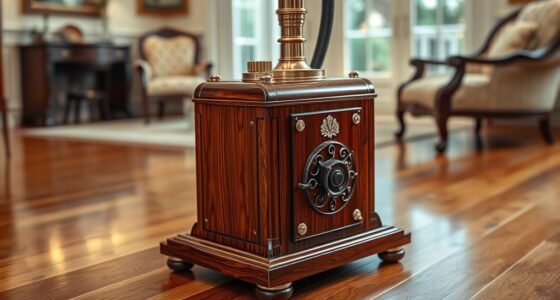Carbon paper thermostats were early devices that used the conductive properties of carbon paper to sense temperature changes and control heating systems automatically. They marked a step forward from mechanical switches by offering more direct regulation. However, limitations like inconsistent conductivity and environmental sensitivity affected their reliability. These primitive controls laid important groundwork for modern smart thermostats. If you explore further, you’ll discover how these early innovations influenced the advanced heating controls we use today.
Key Takeaways
- Early carbon paper thermostats used temperature-dependent electrical resistance to control heating systems.
- They represented an advancement from mechanical switches towards more automated temperature regulation.
- Limitations included inconsistent conductivity and environmental sensitivity, affecting reliability.
- These thermostats laid the foundation for modern smart controls by integrating electrical sensing principles.
- They marked a significant step in transitioning from manual to automated heating regulation systems.

Have you ever wondered how early thermostats maintained temperature control? Back in the day, the concept of regulating indoor temperature was quite primitive compared to today’s smart systems. The earliest forms of thermostats relied heavily on simple, mechanical principles. One of the most intriguing early devices was the carbon paper thermostat, a primitive yet innovative step in heating technology. To understand how it worked, it’s helpful to look at its historical development and the technological limitations that shaped its design. During the late 19th and early 20th centuries, engineers sought ways to automate temperature regulation, but they faced significant hurdles. Many of these early devices used bimetallic strips or mercury switches, which, while functional, were often slow and imprecise. The carbon paper thermostat emerged as an attempt to improve upon these limitations by using the conductive properties of carbon to detect temperature changes. This innovation aimed to create a more reliable control mechanism by leveraging the electrical resistance changes of carbon paper. The development of carbon paper thermostats was driven by the desire for a more reliable and straightforward method to control heating systems. Unlike earlier mechanical switches, these thermostats employed a strip of carbon paper that would change its electrical resistance with temperature fluctuations. When the ambient temperature rose or fell, the resistance of the carbon paper would alter, triggering a relay or switch that would turn the heating device on or off. This approach was quite innovative at the time because it allowed for a more direct and responsive control mechanism without the need for complex mechanical parts. However, despite their ingenuity, these devices still had considerable limitations. The main issue was the inconsistent conductivity of carbon paper, which could vary due to manufacturing imperfections or environmental factors like humidity. This inconsistency meant that the thermostat’s accuracy was often compromised, leading to uneven heating or frequent cycling.
Furthermore, technological limitations of the era meant that these thermostats were bulky and relatively fragile. They required manual calibration and were sensitive to external influences, which limited their reliability over time. Despite these shortcomings, carbon paper thermostats represented a significant step forward from purely manual systems. They marked the beginning of an era where temperature control could be partially automated, laying the groundwork for more sophisticated and precise thermostats in the future. While they are largely obsolete today, understanding their historical development and technological limitations helps highlight how far heating regulation technology has come—from primitive carbon paper devices to the intelligent, interconnected systems we rely on now.
Frequently Asked Questions
How Accurate Were Carbon Paper Thermostats Compared to Modern Models?
When comparing accuracy, carbon paper thermostats were quite basic and less reliable than modern models. They relied on simple calibration methods, which often led to inaccuracies due to wear or misadjustment. Today’s smart thermostats use advanced sensors and precise calibration techniques, offering far better accuracy. So, you’ll find that modern thermostats provide consistent, precise temperature control, unlike the more primitive carbon paper versions that were prone to errors and needed frequent adjustments.
What Were the Main Limitations of Early Carbon Paper Thermostats?
You’d find early carbon paper thermostats limited by their unreliable power sources, which often caused inconsistent operation. Their temperature range was narrow, making it hard to maintain precise comfort levels. Additionally, these thermostats lacked the ability to adapt to changing conditions, leading to less accurate temperature regulation. Overall, their simplicity meant they couldn’t match the reliability or flexibility of modern smart controls, making them a primitive solution for climate management.
How Did Users Calibrate or Adjust These Thermostats?
Think of it as fine-tuning a musical instrument. You would perform manual calibration by adjusting the thermostat’s dials or levers, making small user adjustments until the temperature matched your desired setting. Users typically calibrated these thermostats by observing the temperature and tweaking the controls to guarantee consistent comfort. This hands-on process required patience, but it was essential for maintaining the proper environment without the advanced features we enjoy today.
Were Carbon Paper Thermostats Widely Adopted in Homes or Industries?
You might wonder if carbon paper thermostats saw widespread use in homes or industries. Historically, their usage was limited, mainly confined to specific industrial applications where precise temperature control was essential. Industry adoption was moderate but not extensive, as these thermostats were eventually replaced by more advanced, reliable solutions. In homes, they were rarely used, making way for modern digital and smart thermostats that offer greater accuracy and convenience.
What Materials Were Used in Manufacturing Carbon Paper Thermostats?
You might find it surprising, but in manufacturing carbon paper thermostats, they used simple materials like carbon paper and metal contacts. The manufacturing process emphasized material durability, ensuring the device could withstand repeated use. The carbon paper acted as a sensitive element, while sturdy metals maintained reliable connections. These choices helped the thermostats function consistently, laying the groundwork for more advanced, durable control systems we rely on today.
Conclusion
So, while carbon paper thermostats may seem like relics of the past, they laid the groundwork for today’s smart controls. What’s truly fascinating is how this primitive technology hints at the future—where your thermostat might know your habits before you do. Could it be that the next leap in comfort and efficiency is just around the corner? Stay tuned, because the evolution of temperature control is far from over, and the best is yet to come.









